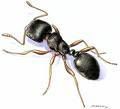Tuesday, June 21, 2005
Drywood termite info plus a new termite treatment
First, if you're getting termites in Florida this time of year, it's likely to be the drywood kind. This is good since they're not as bad as the Eastern subterranean termites. The drywood colonies are much smaller and take years before damage is done.
He also gives some useful details about identifying drywood termites. You don't need to know what a termite looks like to know that they are around. You often can identify them by what they leave behind. It's kind of gross, but be on the lookout for cellulose or wood pellets. Since drywood termites can't directly digest wood, they'll excrete these as their fecal waste. Another waste byproduct of the drywood termites is their wings. The alates shed their wings quickly. These termite wings can be identified by what he calls an "iridescent quality". Another feature of the wing is the 3, 5, or 7 veins on the leading edge. In addition to visual clues, the tunnels that they leave behind can be identified by touch. It'll feel smooth.
The pest control owner described two techniques to get rid of the termites. He considered the easiest and quickest method to be tenting in which a gas is pumped in. The problem is that drywood termites often return since there's no chemicals left behind. I don't know why he considers this the easiest method since it takes a lot of work to get the house ready for the termite fumigation and requires up to four days of vacancy.
The other method he mentioned is something that I've seen before but I don't think is too common. He's in the process of getting certified in this method so perhaps it is new. It involves heating the house to 140°F for 4 hours. This seems like it may be a good home remedy for termites. During a hot summer day, close up the house and blast the heater all day. It would probably be safer to let a professional try this. You'll have to make sure that anything flamable or prone to heat damage is removed from the house. The nice thing about this heat method is that there is no poison, chemicals, or pesticides to worry about after its done.
Technorati Tags: insects, termites
